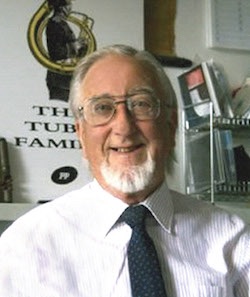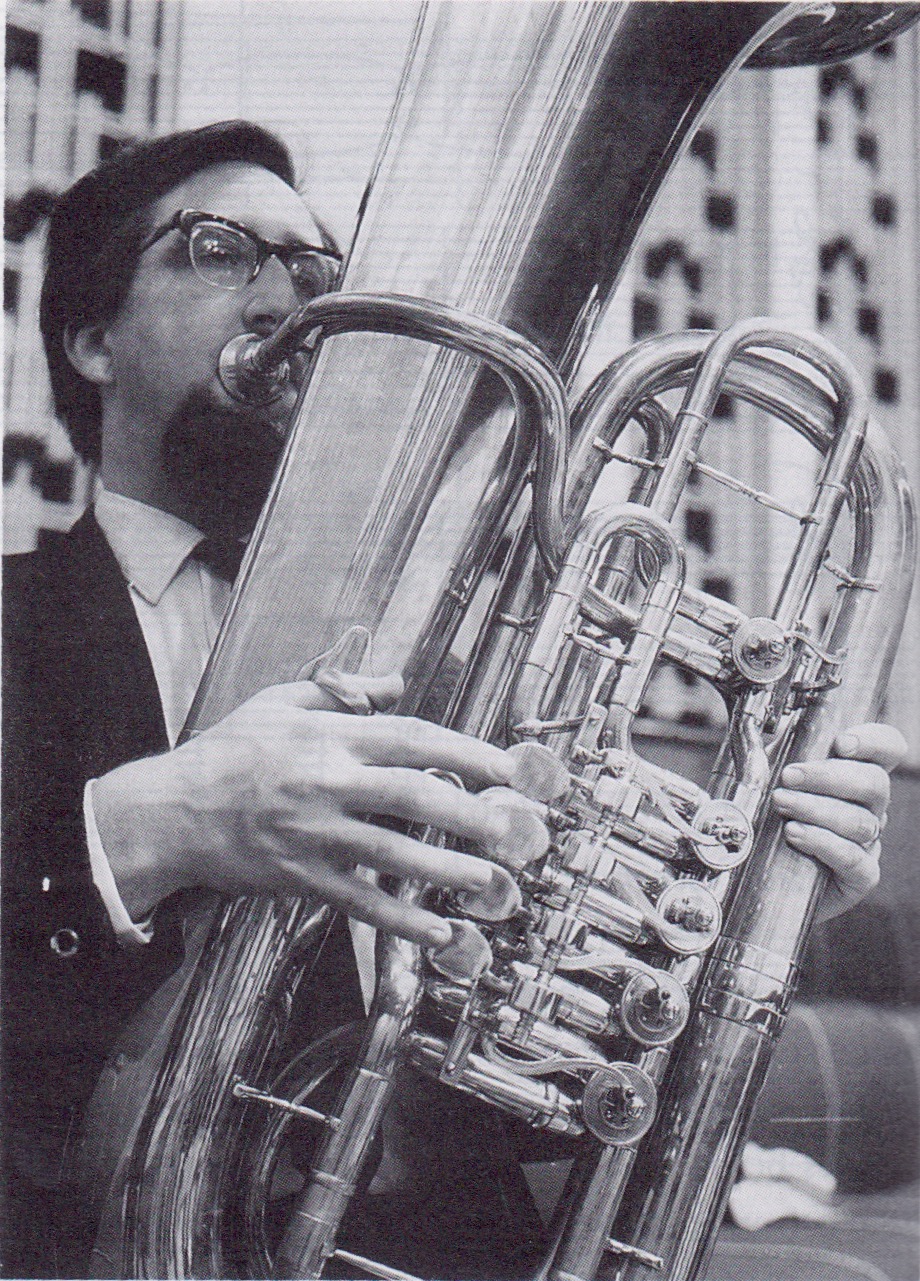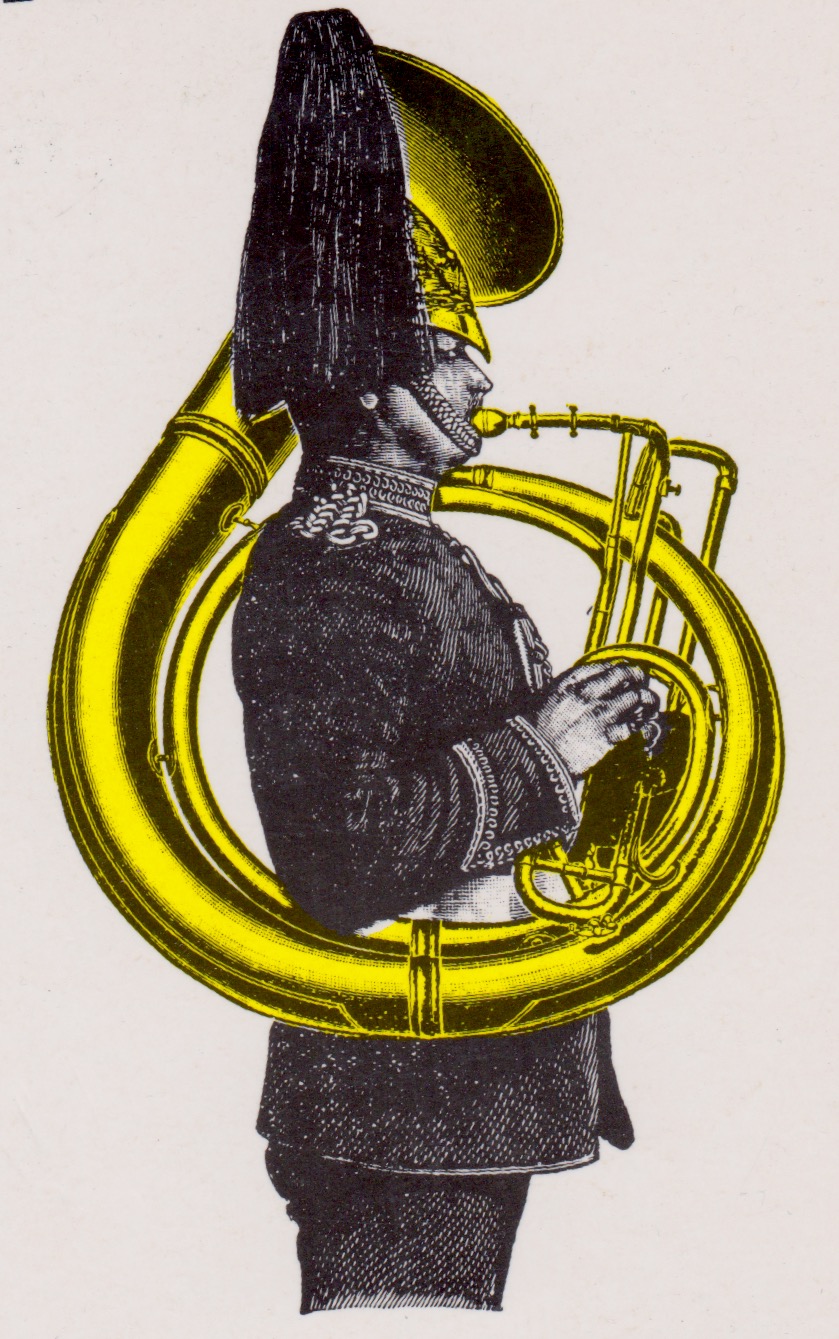Tel: +1 469 836 2108 | Email : drobnakbrass@gmail.com | Login
Clifford Bevan (b. 1934)


Biography from The Tuba Family
Clifford Bevan was born in Manchester and served an apprenticeship as a compositor before studying trombone and composition at the Royal Academy of Music. After freelancing he became chief arranger and pianist of The Temperance Seven during their chart-topping period, then spent eight years as principal tuba of the Royal Liverpool Philharmonic Orchestra. Moving back to London, he played tuba and euphonium with all the leading symphony, opera and broadcasting orchestras, n the West End Theatre and sessions. Since the first edition of The Tuba Family, in 1978, he has contributed to numerous reference works and journals as well as writing more books, about musical instruments and theory. He now divides his time between Winchester and London, writing, arranging, teaching and running Piccolo Press, playing tuba, euphonium, ophicleide, serpent, cimbasso and bass trombone in music ranging from opera to big band. He holds BMus and PhD degrees from London University.
Biography from ITEA Journal, Volume 45 Number 2
Clifford James Bevan. BMus (London), PhD (London, Music History), FLCM (Composition), LRAM (Trombone, Performers), ARCM (Theoretical Music). Born Manchester, England 1934. Played Eb horn in brass band conducted by father, then trombone; later also in amateur orchestras and jazz bands while apprentice compositor and then printers' reader. 1956-60 Royal Academy of Music, London: Trombone (Sidney Langston) and Composition (Howard Ferguson). 1960 first published article. 1960-61 freelance; 1st Trombone Sadler's Wells Royal Ballet; 1961-64 pianist and chief arranger, The Temperance Seven. (Several UK Charts entries, including Number 1). 1964-72 Tuba, Royal Liverpool Philharmonic Orchestra; 1967-70 also Orchestra Manager; 1970-72 also General Manager, Manchester Mozart Orchestra. 1970 first published composition. From 1971 music publishing as MGP, later Piccolo Press, including music books. 1972-75 freelance London (tuba and euphonium), symphony, opera and theatre orchestras, big bands, sessions. Decided that playing with the Mike Gibbs Band (jazz-rock) was the ultimate for a tuba-player. 1975-78 Music & Dance Officer, Southern Arts Association; member ACGB Music Panel Jazz Sub-Committee; music columnist Entertainment & Arts Management. 1978 first edition of The Tuba Family. Freelance (low brass, including cimbasso), teaching, examining, research, writing, lecture-recitals, master-classes; member London Serpent Trio and gave first-known full-length ophicleide recital. From 1993 Joint Historical Instruments Editor, ITEA Journal. Ten published books, plus compositions and arrangements. Compositions include music for TV, stage and film. Contributor to New Grove Dictionaries of Music, Musical Instruments and Jazz, along with Tuba Source Book amongst others. Recipient Manchester Typographical Society Award 1955; Edward Hecht and Oliviera Prescott Prizes (Composition) 1956-60; HBS Christopher Monk Award 2008; ITEA Lifetime Achievement Award 2010. Personal highspots: 2008 Clifford Bevan Award for Excellence in Research established by ITEA; Carnegie Hall concert with Royal Philharmonic Orchestra; filming in Cinecittà Studios, Rome with Temperance Seven; ophicleide with Grimethorpe Brass Band and Orquesta do Porto; euphonium at Theatre Royal, Drury Lane and in Royal Artillery Band recordings; conducting band of 59 serpent-players at St John's, Smith Square, London. Most pleasing? When he was told that an extract from his article "Brass Band Contests: art or sport?" had appeared as the comprehension test in a national examination board's English Language Advanced Level Paper. Stopped playing and teaching brass aged 80 owing to a trapped nerve in the back, but piano-playing is improving―and ambition achieved: now volunteer with Watercress Line, heritage steam railway. Still researches and writes (watch this space)―with three more books in preparation.

Help support this website by buying me a coffee!
Publications - Books and Journal Articles
The Tuba Family, 1978.
The Tuba Family. 2nd ed. Piccolo Press, Wincester, England: 2000.
Final Thoughts on the Cimbasso, part 1. In TUBA Journal, 26, 3 (Spring 1999), 56-7.
Musical Instrument Collections in the British Isles. Winchester, 1990.
The Prussian Trumpet. In Galpin Society Journal. 61 (1988), 112-4.
The Saxtuba and Organological Vituperation. In Galpin Society Journal 63 (1990), 135-146.
Stephen Wick and the Informed Approach. In TUBA Journal 25, 4 (Summer 1998).
With the appearance of “The Tuba Family” in 1978, released by the distinguished British publisher, Faber & Faber Limited, Clifford Bevan has assisted a generation of brass players and researchers to better understand the evolution and musical role of the tuba and other low brass instruments. Merging an instrumentalist’s curiosity, intuitive knowledge, and wit with a musicologist’s precision of thought and breadth of knowledge, Bevan treated the tuba and related instruments in all of their realms - historical development, acoustics, musical setting and repertoire, and leading players and composers. While the word “definitive” has lost meaning in recent years, “The Tuba Family” and its second edition, published in 2000 and increasing in size twofold the original edition from 303 pages to 640 pages, can be considered the definitive treatment of the instrument.
Bevan’s contributions to the brass field, however, are not represented solely by the publication of “The Tuba Family.” He participated in the legendary 1995 Historic Brass Society’s Symposium, preparing a ground-breaking treatment of the cimbasso that has been widely received in the brass world. He has served as an officer of the Galpin Society and contributor to that organization’s journal and, since 1993, he has written columns in the International Tuba Euphonium Association Journal, preparing widely acclaimed educational essays as well as serving as one of the few low brass humorists writing today. As arranger, composer, editor, and publisher, Dr. Bevan has prepared and written compositions for brass and winds that have been widely performed and recorded.
The significance of Bevan’s work for the brass field extends beyond the research desk and archives. Having studied at the Royal Academy of Music, Bevan was principal tuba in the Royal Liverpool Philharmonic Orchestra as well as an active London West End session player, freelancing with the BBC, Royal Opera House, and English National Opera orchestras. Also, Bevan’s performing career has taken him into rather unusual realms far beyond the worlds of brass, jazz, and classical music. Bevan was the arranger, trombonist, tubist, and pianist in “The Temperance Seven,” a popular music group with a 1961 “British #1, top of the charts” record, “You’re Driving me Crazy.” Managed by “the fifth Beatle,” Sir George Martin, the Beatles appeared as the warm-up anti for the Temperance Seven, and Lennon-McCartney’s “Honey Pie” was an homage to the ensemble.
As an historical brass player, Bevan was an official member of the London Serpent Trio during the time of Christopher Monk and has assumed that ensemble’s role as spokesperson. In 1990, he presented the first modern recital for ophicleide at the Horseman Museum and has served as serpent and ophicleide tutor at the Dartington International Music Festival. Dr. Bevan continues to be engaged by the Horseman, the University of Edinburgh Collection of Historical Musical Instruments, and other museums for instrument demonstrations.
In 2008, the international Historic Brass Society presented him with the Christopher Monk Award, considered the highest honor in the historical brass world and, at this event, ITEA will award the first Clifford Bevan Award for Excellence in Research. The International tuba Euphonium Association is pleased to present Clifford Bevan its highest distinction, the Lifetime Achievement Award.
-2010 International Tuba Euphonium Conference Program
